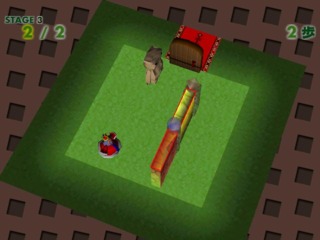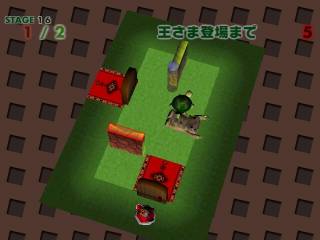Overview
Golem no Maigo (also commonly known as "The Lost Golem" in English) is a Japan-exclusive puzzle game for the Dreamcast released in 2000. Taking control of the titular golem, the player has two tasks that they must fulfill in order to complete every level: 1. guide a lost king safely to the door at the end of every level and 2. preserve a set number of walls used to guide the king without destroying them. As the player proceeds through the game, various obstacles and enemy types are introduced as well to increase the difficulty. In-between sets of levels, the story is advanced through cutscenes portrayed in pre-rendered stills and non-voiced dialog.
Gameplay
 An early level in the game.
An early level in the game.Guiding the king to the exit in Golem no Maigo is a matter of determining his predetermined movement rules and then subsequently shifting the walls available in each level to accommodate them. As such, at first, the king will always move straight until he reaches either a wall or the outer boundary of the level. Which way he then turns is dependent on a set of different conditions. If he's able to do so, he'll always turn left. Putting up a wall to his left will therefore instead compel him to turn to the right and in the event that he's surrounded on three sides, he'll reverse course and walk back in the direction from which he came. (Having him completely boxed in results in a game over.) It is also possible to use the walls to push the king in different directions. When he reaches the end of the end of a level, he'll jump up and down to indicate that he's ready to move forward and have the door opened by the golem, although he'll only do so if he directly runs into said door face-to-face, otherwise opting to walk right past it when walking in any other direction. Additionally, each level usually has a timer that goes off at the start that indicates when the king will actually start moving from his initial position, allowing the golem to initially set some things up if necessary.
The ways in which walls can be moved are dictated predominantly in accordance to the types of things to which they are attached. If a wall is only attached to a red pole, outer wall, or perpendicular to a pit in a level, they can only be pushed forward relative to the golem's position. If there is no other pole or outer wall for it to catch onto, the wall will propel forward until it reaches either the outer edge of a level or encounters a pit, with either case resulting in it being taken completely out of play. However, if a wall is attached to a single blue pole, then it can be rotated at 90 degree angles. Should that wall then be attached to two blue poles, the wall will act as though it's attached to one red pole and can only be pushed forward. Being stuck onto a red pole and a blue pole, meanwhile, allows the wall to continue to be rotated around as normal. Red poles can also be destroyed; although they can exist in isolation at the start of every level, once a wall is attached to it, there must always be at least one wall stuck to it at all times or else it will disappear when there are no walls next to it remaining.
 Other obstacles such as pits and enemies are slowly introduced as players progress through the game.
Other obstacles such as pits and enemies are slowly introduced as players progress through the game.These walls also relate the other goal that must be fulfilled in each level, since a certain number of them must be preserved and connected to each other via the poles in addition to ensuring the king's safe passage in order to proceed. This is represented by a counter that's presented as a fraction in the upper-left corner of the screen. Each level is assigned a red-tinted wall that must be preserved at all costs and that fraction changes as more walls are connected to it via poles. As long as that number is attained at minimum, regardless of whether the positions of the other walls are parallel to the red one or perpendicular to it, the player passes the level and is allowed to move onto the next one. While it is not necessary to connect any excess walls to win each level, it is nevertheless possible to destroy too many of them, which triggers a game over.
 Players are rewarded with cutscenes for completing batches of levels.
Players are rewarded with cutscenes for completing batches of levels.Although the game initially starts off with just walls and poles to deal with while guiding the king, Golem no Maigo also eventually introduces enemies such as turtles and ghosts that have their own routing rules. While running into them as the golem merely results in it falling down and being temporarily out of commission, having the king touch them results in a game over and requires restarting the level.
Aside from over several dozen levels that constitute the single player portion of Golem no Maigo, the game also has a competitive multiplayer mode in which players race to rescue the king first, as well as a level editor in which one's work can naturally be saved to the VMU. At the time of the game's release, players were also able to download additional levels from the development team's web site in game that were made by other players, but that feature has since ceased to be operational.
Development History
Golem no Maigo was developed mostly by Shuichi Ishikawa while he was a student at Kyushu University, with some additional help for the game's art and music assets. As the only game officially published by Caramelpot before being disbanded, the game only sold a few hundred copies in its lifetime, making it one of the Dreamcast's rarer Japanese games.
Log in to comment